 A few years ago, I looked at what genres are disproportionately popular with cinema audiences around the world. We learned that Italians enjoyed more comedies, that Asian nations love action, Europeans love drama and that romance burns brightest among Mexican film fans.
A few years ago, I looked at what genres are disproportionately popular with cinema audiences around the world. We learned that Italians enjoyed more comedies, that Asian nations love action, Europeans love drama and that romance burns brightest among Mexican film fans.
That study looked at how films were received in cinemas, but a few weeks ago, it occurred to me that there was another group of people whose genre tastes we could measure – the filmmakers making the movies.
So I set about building a database of the movies made in each country and what genre they are. Now, I’m willing to concede that the scale of the research I did for today’s article was slightly out of proportion with the value of its findings, even by my standards. By the time I’d finished, I had tracked 117,134 movies made in 151 countries over the past twenty years. So I’m going to split the results into two articles.
Today I’ll share the global genre trends and next week I’ll discuss individual countries.
What in the world are filmmakers making?
Just over half of all films made anywhere in the world over the past twenty years are Dramas (51.6%). Other popular genres include Comedy (28.4% of movies made), Thrillers (12.4%), Romance (11.6%), Action (11.2%) and Horror (10.6%).
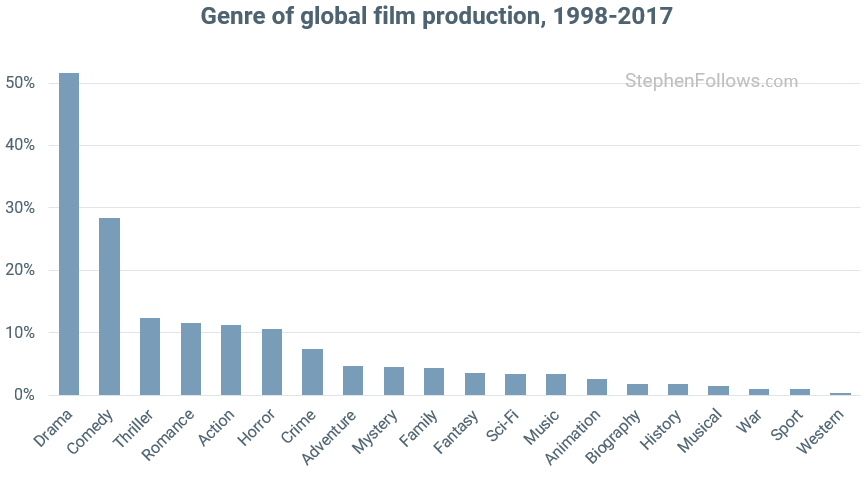
Note: Some of today’s charts may add up to more than 100% as each film could have up to three genres. See Notes section at the end of the article for details.
The dominance of drama as a genre is perhaps not surprising when we consider the following:
- Drama is the cheapest genre to produce as movies don’t necessarily require special sets, costumes, locations, props, special/visual effects, etc.
- Drama has the broadest definition of all genres – everything that happens anywhere ever is a drama. Conversely, other genres have a higher bar for classification, such as the need for high-octane events for a movie to be classed as Action, scary events to be Horror, funny elements to be a Comedy, etc.
Film marketers often complain that “Drama is not a genre”, insofar as it doesn’t give the potential audience member any clues as to what to expect. Conversely, simply stating that a movie is a Western conveys a great deal of information about what may be on offer, including time period, location, tone, plot elements, character tropes and more.
The data from today’s research suggests that the broad nature of Drama may be further compounded by the sheer number of such movies on offer. With so many films claiming the Drama moniker, audiences may find it impossible to form useful genre-wide expectations, unlike the narrow pool of Westerns.
How are film production levels changing over time?
Global film production is booming, thanks in large part to new technologies. It’s cheaper and easier than ever before to shoot, edit and distribute a feature film, not to mention the effect of the internet in sharing ideas, knowledge and advice.
It’s not possible to give a definitive figure for the exact number of films made each year but the growth can be viewed through a proxy, such as the number of new feature films listed on IMDb each year.
IMDb currently has 12,597 feature films listed as having first been released in 2017 – twice the figure for ten years ago. 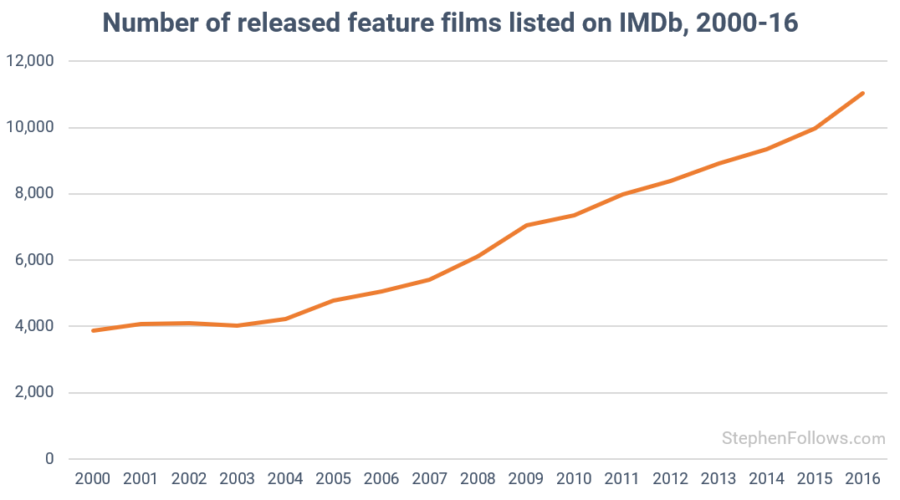
Which genres are growing in popularity?
In my research last year into horror movies, I showed how the horror genre has grown incredibly in the past decade or so. Twenty years ago, horror movies accounted for 4.3% of all movies made, whereas in 2017 they represented 12.4%.
Other genres which are growing in popularity are History, Sci-Fi and Biography.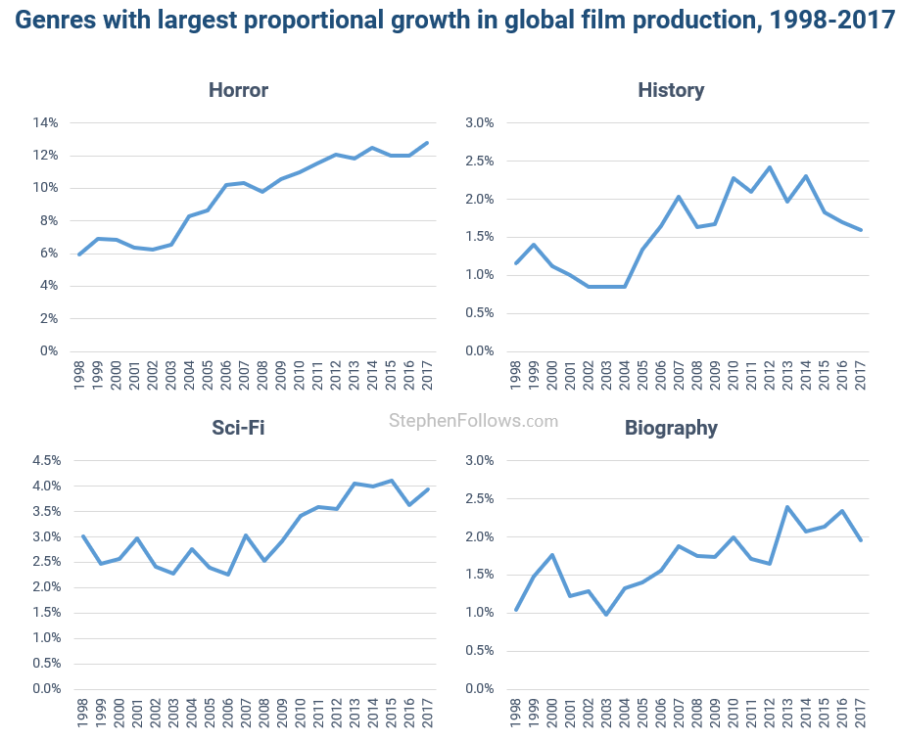
Which genres are waning?
Filmmakers seem to have much less love for Romance than they once did. In 1998, 15.9% of movies made were Romances whereas last year it was just 7.6%. That being said, they’re also losing interest in War movies, along with Action and Crime movies.
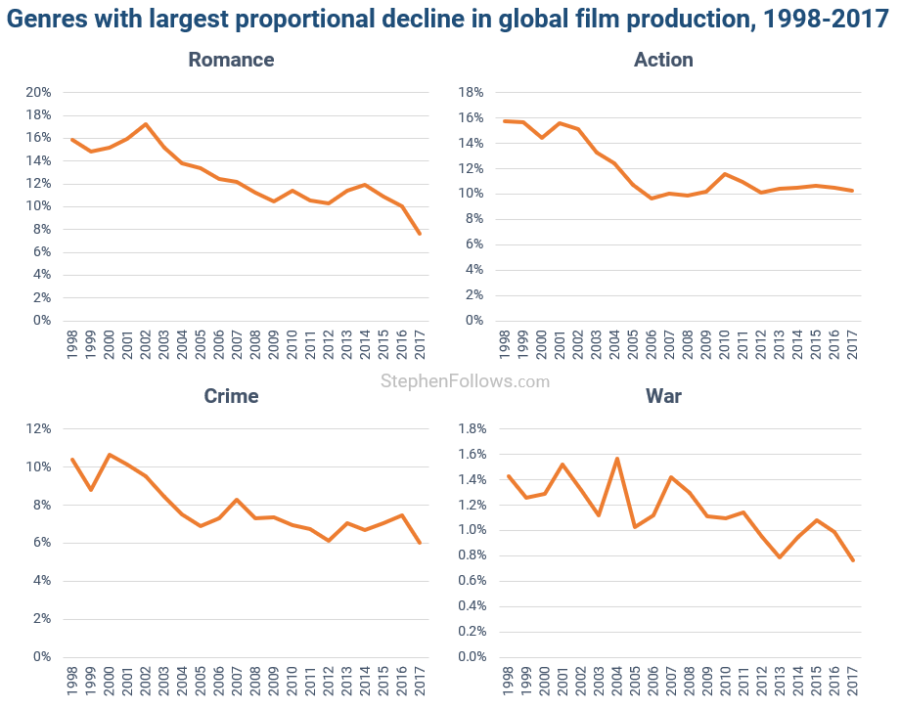
Remember that these charts show the relative interest, not the raw number of films made. Global film production is increasing and so even if a genre is comparatively less popular than it once was, there still may be more movies made in that genre than in previous years.
For example, although romantic films make up a smaller percentage of movies made, their raw production numbers are still increasing. In 1998, there were 410 Romance movies made globally and in 2017 the figure stood at 887. Their numbers may have doubled but because global film production quadrupled over the same period, they appear relatively less popular.
Notes
The data for today’s article came from a variety of sources, including IMDb, Wikipedia and Movie Insider. This research is focused on fiction feature films (so not short films, TV movies, documentaries, etc) and includes all movies produced, not just those that were released in cinemas.
I allowed each movie to have up to three genres, which was derived as an aggregate of all the sources listing that movie. Across the dataset, the average movie had 1.7 genre classifications. The 20 genres I included were Action, Adventure, Animation, Biography, Comedy, Crime, Drama, Family, Fantasy, History, Horror, Music, Musical, Mystery, Romance, Sci-Fi, Sport, Thriller, War and Western.
It’s worth noting that we’re measuring production numbers, not amount spent, meaning that a micro-budget film has the same weight as a mega-studio tentpole. This instinctively feels like a better measure of a nation’s filmmaking tastes, as otherwise a country could make 660 micro-budget dramas and play host to one Hollywood action film and the nation’s output would be classed as “50% action movies”.
Epilogue
Next week I’m going to look at which countries prefer to make which genres.

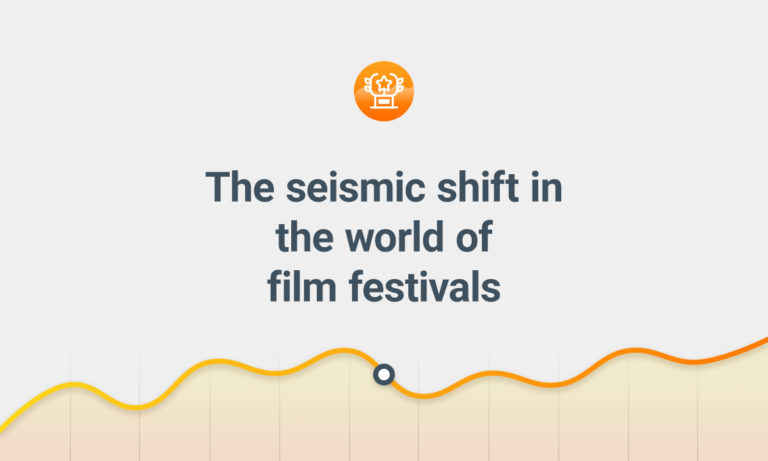



Comments
You wrote –
“It’s worth noting that we’re measuring production numbers, not amount spent, meaning that a micro-budget film has the same weight as a mega-studio tentpole. This instinctively feels like a better measure of a nation’s filmmaking tastes, as otherwise a country could make 660 micro-budget dramas and play host to one Hollywood action film and the nation’s output would be classed as ‘50% action movies’.”
I disagree totally! It reflects what aspirant filmmakers can afford to make!
I would have thought that it is ONLY what people want to watch that counts. Fresh graduates from film schools seem to have a depressing tendency to want to make gritty urban kitchen-sink dramas – films that have lines like “Dad, I’m pregnant.” and “Look out! He’s got a knife!”
Everybody has their own idea of what makes a good movie, but the mainstream movie-goer is pretty clear: he or she does not want to see gritty urban kitchen-sink dramas. They are even more clear that they do not want to see gritty urban kitchen-sink dramas with poor production values such as point-n-shoot, location-based cinematography and poor scores, or even no music whatsoever!
I would have thought that if over half the number of tickets sold, are for the usual comedy or fantasy/action/thriller movies featuring loud bangs and gratuitous violence, then that should be the measure of all things. Making movies is, after all, a part of the entertainment industry – so a movie that nobody wants to watch is a movie that probably should not have been made, or perhaps is better classed as an art-installation.
660 micro-budget projects reflect the need for first-time producers, directors and actors to learn their trade and cut their teeth on something that will not break the bank. Drama is cheap. Spectacular action thrillers featuring loud bangs and gratuitous violence cost money.
Your graphs make a handy reference. In discussion, usually on the internet, I constantly come across bemoaning and laments that “hollywood has run out of ideas” or “all they make is sequels/superheroes/remakes”, “nobody makes movies for adults anymore”, etc. I always counter by saying there are more films made now than ever before, more mediums, more distribution, more variety, more diversity than ever in history. but I haven’t (yet) amassed any handy supporting links to demonstrate that I’m being honest and accurate.
I get that the box-office is monolithically dominated by things disney owns–animated, starwars, marvel, pixar and that the top ten films in a year represent a staggering concentration and proportion of total box-office dollars into a handful of franchises and cartoons. but those films also finance the cool indie movie that only made 79 dollars, and the haughty period film adapting an elitist type novel that made just 9 people go squee, etc. I have access to plenty of cinema fare that aren’t the handful that make all the money.–at any given moment in my city there are 50-80 big screen options open to me that include foreign films, anime, classic cinema, indie fare, adult focused dramas, documentaries….anything i might like. why shouldn’t people see the tent poles if they want–they have other options, no one is force-feeding them(i say them, but i’m crazy about cartoons and sci-fi and sometimes even superheroes too; i just also happen to gluttonously consume all kinds of movies).
I have access to more movies at the theatre then i can find time and money to see. Once we add tv/streaming/internet, i have access to exponentially more movies than i could even stay aware of, let alone watch–and i put a lot of screen-time in, more than most people. So I really dislike, and always challenge the myth of the lost art of movies and the absurd baseless fear that there’s just remakes, superheroes and sequels out there. It is repeated and unquestioned so often that it acquires a truthiness. You can’t consider viewing options you don’t believe exist.
Your research demonstrates that the film industry is growing explosively and that films of all shapes and sizes are being made, even if it doesn’t say anything specific about type of film such as sequel or remake. I’ve only just discovered your site. I look forward to poking around.
Thank you for taking the time to create this study.
Hi. I’m a Japanese college student and doing graduation studies about Horror Movies.
I would like to quote the graph on this site. If copyright is involved, I would like to summarize the text and use it. Is it possible.
Is it possible to get a hard copy of your book?
Hi Bill. Which book? The crowdfunding book is on Amazon (https://www.amazon.co.uk/How-Crowdfund-Your-Film-Strategies/dp/0857301837) but the Horror Report is digital only.
Fa sho!
Hi! As always, thank YOU for compiling this information. Your effort is appreciated!
Where do I find the next article?
“Next week I’m going to look at which countries prefer to make which genres.“
Lastly, would be interesting to see “which countries prefer to BUY which genre.” Do you have a piece on this I accidentally overlooked?
Sincerely
-N
Wait. I wrote that in a silly way!
“The genre each country BUYS the most”
Thanks! It’s here https://stephenfollows.com/genre-film-production-changes-around-world/